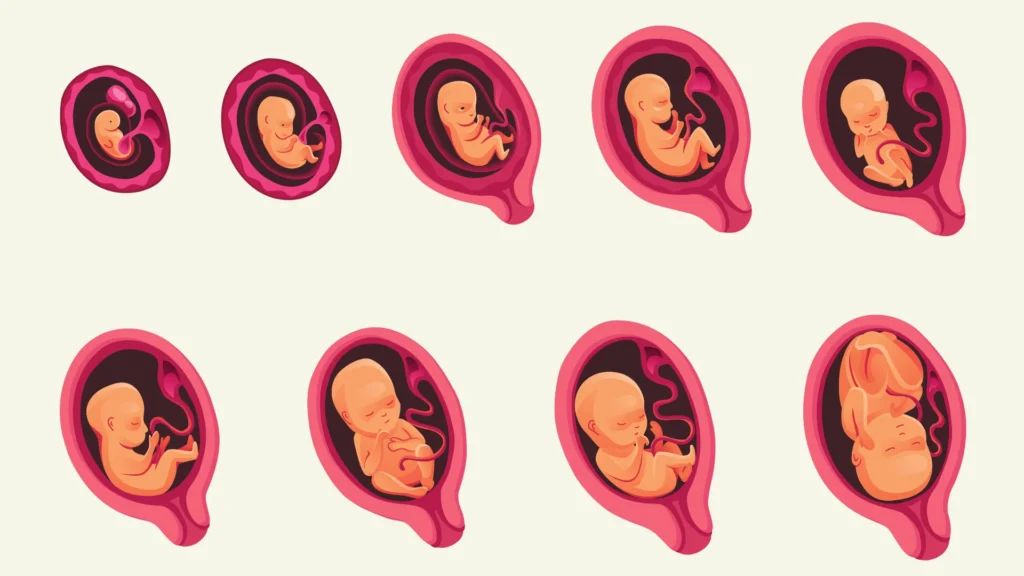Pregnancy is a unique journey filled with a mixture of excitement, anticipation, and for some, a bit of anxiety. Understanding the changes that occur as the weeks go by can help you embrace this period with confidence and excitement. This article aims to guide you through the stages of pregnancy, broken down into the three trimesters, and highlight the key fetal developments throughout these stages. From conception to full-term pregnancy, we’ll walk you through this fascinating timeline.

Although each pregnancy is unique, one constant is that it unfolds in three distinct stages known as trimesters. Each trimester lasts for about 12 to 14 weeks, providing a useful framework for understanding the stages of fetal development. The week-by-week progression of pregnancy is calculated starting from the first day of your last menstrual period, which is typically about two weeks before conception.
In this article, we’ll take you on a journey through the 40 weeks of pregnancy, giving you insights into what to expect during each trimester. This guide will serve as an excellent primer and reference point, whether you’re an expectant parent or someone who wants to understand more about the incredible process of bringing a new life into the world.
Introduction to Pregnancy Trimesters
The term ‘trimester’ means ‘three months.’ A full-term pregnancy lasts about 40 weeks, so it’s roughly divided into three trimesters. The first trimester spans from the first day of your last period to the end of the 12th week of pregnancy. The second trimester begins in week 13 and extends through week 28. The third trimester, which lasts from weeks 29 through 40, is the final stretch that ends with the birth of your baby.
Understanding the progression of the trimesters allows you to track the development of your baby and understand the many changes your body undergoes. In general, the first trimester involves rapid fetal development with the formation of major organs and body systems. The second trimester brings a slowing in organ development but significant growth in size, while the third trimester is a period of rapid growth and further development of organs, particularly the lungs and brain.
Week-by-Week Breakdown of the First Trimester

In the first trimester of pregnancy, which starts from the first day of your last period and continues until the end of week 12, you may experience many changes as your body adjusts to nurturing a new life.
Weeks 1-2: Your pregnancy officially begins on the first day of your last period. Even though you’re not pregnant yet, this timeframe is included in your 40-week pregnancy timeline.
Weeks 3-4: The process of conception occurs, and the fertilized egg travels down the fallopian tube and implants itself into the uterus. Early pregnancy is a critical time for fetal development as the embryo forms its most basic structures.
Weeks 5-8: The embryo’s heartbeat can be detected around the 6th week, and by the end of the 8th week, the embryo now referred to as a fetus, measures about half an inch long. At this stage of development, the initial facial features become visible and the neural tube, which shapes the brain and spinal cord, completes its formation.
Weeks 9-12: By week 9, all major organs and systems have started to form. By the 12th week, the fetus is fully formed and has begun to move and kick, though you likely won’t feel this movement yet. Hormonal changes may lead to symptoms like nausea, fatigue, and frequent urination.
The first trimester is a time of extraordinary change and development. It’s during these early weeks that the fetus is most vulnerable, so it’s especially important to take care of yourself and get good prenatal care.
Key Developments During the Second Trimester
The second trimester of pregnancy spans from the 13th to the 28th week. This period is often considered the “golden trimester” because many of the unpleasant effects of early pregnancy fade.
Weeks 13-18: You may notice your energy levels returning and your appetite increasing. At this stage, the fetus has grown to the size of a lemon, and its unique fingerprints are already in place.
Weeks 19-23: Around week 20, you’ll reach the halfway point of your pregnancy. You might start to feel your baby moving around as they explore their surroundings in the womb.
Weeks 24-28: The baby’s brain continues to develop, and the nervous system is sophisticated enough to control some bodily functions. By the end of this trimester, your baby will be nearly two-thirds of its birth length and weigh about between 2 and 2.5 pounds (around 1 kg).
During the second trimester, you’ll likely feel more comfortable and have a noticeable baby bump. This trimester is a good time to start planning for the baby’s arrival.
The Final Stretch: Week-by-Week Journey Through the Third Trimester
The third trimester of pregnancy begins in week 29 and lasts until you deliver your baby, which is usually around week 40. This is the final stretch of your pregnancy, and your body will go through many changes as it prepares for labor and delivery.
Weeks 29-32: The baby continues to grow and gain weight. By the 30th week, your baby may weigh nearly 3 pounds and measure about 16 inches long from head to heel. You may feel stronger movements and kicks as the baby gets larger and stronger.
Weeks 33-37: These weeks may be uncomfortable as the baby continues to grow. By week 36, the baby’s lungs are fully formed and ready for breathing after birth. The baby will begin to drop lower in your abdomen to prepare for delivery, a process known as lightening.
Weeks 38-40+: You’ve reached full term! The baby is ready to meet you anytime now. However, it’s not uncommon for a pregnancy to last up to 42 weeks. If labor hasn’t started naturally by week 40, your doctor may want to induce labor to avoid complications.
Due Date Calculation and Its Importance

The estimated due date is a key term you’ll often hear throughout your pregnancy. This date is calculated from the first day of your last menstrual period. For many pregnant individuals, this date will fall right around 40 weeks, but it’s important to remember that this is just an estimation.
Knowing your due date isn’t just about marking a special date on the calendar. It’s also important for tracking the progress of your baby’s development. Doctors use the due date to monitor the fetus’s growth and the progress of the pregnancy. It can help to identify if the baby is developing as expected or if there are any potential concerns that need to be addressed.
It’s also worth noting that only about 1 in 20 women give birth on their exact due date. Most women will deliver their baby within a week before or after their due date.
Prenatal Care: Its Role in a Healthy Pregnancy

Prenatal care is a crucial part of a healthy pregnancy. Regular prenatal visits can help your healthcare provider monitor your health and the health of your baby. During these visits, you may have tests and screenings to check for any potential issues and to ensure the fetus is developing well.
During the first prenatal visit, a comprehensive physical examination is conducted, which involves a pelvic exam. Blood and urine tests are taken to check for any underlying health issues. Your doctor will also calculate your due date and discuss any potential risks and necessary lifestyle changes.
Prenatal care is also an opportunity for you to ask any questions you may have and to learn more about what to expect during pregnancy and childbirth. It’s important to communicate openly with your healthcare provider and to inform them about any concerns or issues you may experience.
Changes in the Body During Pregnancy
Pregnancy triggers a range of changes in the body. The hormonal changes that occur can affect almost every organ system in your body, leading to symptoms like fatigue, nausea, frequent urination, and changes in your breasts.
As the pregnancy progresses and the fetus grows, you may experience physical changes such as weight gain and changes in your body shape. Your uterus will grow to accommodate the growing fetus, and you may feel your baby moving, especially in the second and third trimesters.
Digestive issues like heartburn and constipation are common as the pregnancy hormone progesterone relaxes the smooth muscle in your body, including your gastrointestinal tract. You may also notice changes in your skin, hair, and nails due to an increase in hormones.
During the final weeks of pregnancy, your body will begin to prepare for labor. You may experience “nesting” (a sudden urge to clean and organize your home), more frequent contractions (Braxton Hicks), and your baby moving lower into your pelvis.
Preparing for Labor and Delivery
As you enter the final weeks of your pregnancy, it’s time to start preparing for labor and delivery. As your due date draws near, it’s common to experience a blend of anticipation and apprehension.
One important aspect of this preparation is understanding the stages of labor and what to expect. The first stage of labor is the longest and involves regular contractions that open the cervix. The second stage, known as the pushing stage, lasts until the baby is born. The third and final stage of labor involves the delivery of the placenta.
KEY TAKEAWAYS
1. Pregnancy lasts about 40 weeks and is divided into three trimesters.
2. The first trimester involves rapid fetal development and various body changes due to hormonal shifts.
3. The second trimester usually brings relief from early pregnancy symptoms and noticeable baby movements.
4. The third trimester is a period of rapid growth and further development of organs, particularly the lungs and brain.
5. Your due date, calculated from the first day of your last period, helps your doctor monitor your baby’s growth.
6. Regular prenatal care is crucial for monitoring your health and the health of your baby.
FINAL THOUGHTS
In conclusion, pregnancy is a transformative journey. By understanding the pregnancy trimesters and the week-by-week progression, you can be better prepared to navigate through this exciting period of life. From the moment of conception to the final push during delivery, this journey is filled with anticipation and awe at the miraculous process of creating life.
Related Post: The Ultimate Pregnancy Guide: Everything You Need To Know For A Happy And Healthy Pregnancy
Read More: The Essential Roadmap to a Healthy Pregnancy: Nurturing Your Body, Mind, and Relationships
If you found this article helpful, please share it with your friends on WhatsApp, Facebook, or Twitter using the buttons above or below the article.
Frequently Asked Questions (FAQs)
WHAT ARE THE THREE TRIMESTERS OF PREGNANCY?
The pregnancy is divided into three trimesters. The first trimester starts from the first day of your last menstrual period and goes up until week 12. The second trimester is from week 14 to week 28. And the third trimester is from week 29 until the birth at around week 40.
How does fetal development progress during pregnancy trimesters?
During the first trimester, the fetus develops the most rapidly. By week 8, all major organs and body systems have started to form. The second trimester brings a period of growth where the fetus starts to look more human. In the third trimester, the fetus gains weight, and the organs mature further to prepare for life outside the womb.
What are the stages of pregnancy?
The stages of pregnancy refer to the three trimesters that each lasts about 12 to 14 weeks. Each stage is characterized by specific developments and changes in both the mother’s body and the developing baby.
How is the due date calculated?
The due date, or estimated date of delivery, is calculated starting from the first day of your last menstrual period. Although a pregnancy typically lasts 40 weeks, it’s rare for a birth to occur on the exact due date, with only about 5% of births happening on that day.
How do the changes in a woman’s body vary throughout the pregnancy trimesters?
The first trimester often brings fatigue, nausea, and breast changes. The second trimester may bring visible changes like a baby bump and skin changes. In the third trimester, the belly continues to grow, and there can be various other changes like backaches, frequent urination, and Braxton Hicks contractions (false labor pains).
What prenatal care should be taken in each trimester of pregnancy?
Prenatal care is important throughout pregnancy and includes regular doctor visits, a healthy diet, regular exercise as approved by your doctor, and avoiding harmful substances like alcohol and tobacco. Specific screenings and tests are also conducted in different trimesters to monitor the health and development of the fetus.
What can I expect during labor and delivery?
Labor and delivery occur in three stages: early and active labor where the cervix dilates, delivery of the baby, and delivery of the placenta. Every person’s experience is unique, and the duration of labor can vary significantly.
What is a full-term pregnancy?
A full-term pregnancy lasts 40 weeks, counted from the first day of the last period. While this is an average, it’s perfectly normal for a healthy baby to be born two weeks on either side of this estimated due date.
What does “weeks pregnant” mean?
“Weeks pregnant” refers to the length of time that has passed since the first day of your last menstrual period, which is how the duration of a pregnancy is usually measured. For example, if you’re “12 weeks pregnant,” that means 12 weeks have passed since the first day of your last period.





